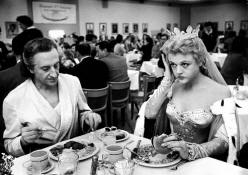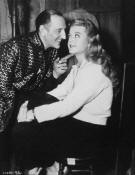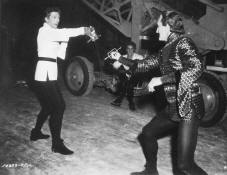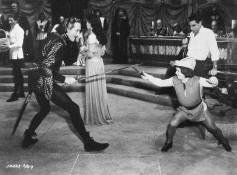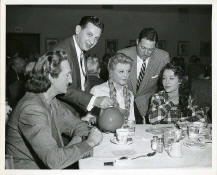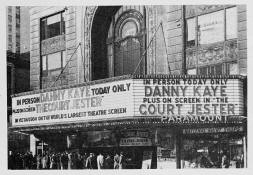The Court Jester
|
|
The Court Jester Laugh-grabbing spoof on costumed swashbucklers with Danny Kaye and bright prospects Costumed swashbucklers undergo a happy spoofing in "The Court Jester" with Danny Kaye heading the fun-poking and making it click. The b.o. cash jingle should match the audience laugh reaction, meaning the Dena production which paramount is releasing has bright prospects at the wickets. While Kaye dominates, giving the film its entertainment-plus factor, there are plenty of credits to spread around for superb comedy assists. Not the least is the three-way, writing-producing-directing function fulfilled by Norman Panama and Melvin Frank. The team drags in virtually every time-honored, and timeworn, medieval drama cliche for Kaye and cast to replay for laughs via not-so-subtle treatment. Another major assist comes from the Sylvia Fine-Sammy Cahn songs, of which there are five all tuned to the Kaye talent. There's the quite mad "Maladjusted Jester"; a lullaby, "Loo-Loo-Loo I'll Take You Dreaming"; a ballad, "My Heart Knows a Lovely Song"; the comedic "They'll Never Outfox the Fox," and "Life Could Not Better Be." With choreography by James Starbuck, Kaye steps off several as production pieces. The big terp click is his work with the American Legion Zouaves, drill team of Post 29, Jackson, Mich. It's plot-spotted for a laugh standout. Overall, Victor Schoen's scoring falls easy on the ear. Castwise, Kaye is surrounded by a group of players long-experienced in costumed dramas. Each contributes tellingly to the comedy spirit which puts the show over. Glynis Johns, fetched from England for the hoydenish Maid Jean role opposite Kaye, does exceedingly well. The same is true of Basil Rathbone, a many-seasoned chief heavy; Angela Lansbury, cutting a pretty picture as the Princess Gwendolyn; Cecil Parker, the not-so-bright King Roderick who has ousted the real royal family; Mildred Natwick, the princess's evil-eyed maid; Robert Middleton, Michael Pate, Herbert Rudley, Noel Drayton, Edward Ashley, John Carradine and others. Production splendors include lavish medieval castle settings and these and other physical furbishing show up fine in VistaVision and Technicolor as lensed by Ray June. Editing by Tom McAdoo is good. Brog. —Variety, February 1, 1956 |
"It stood to reason that somebody would eventually cut loose and do a slam-bang burlesque on recent movies about knighthood and derring-do. ... And we are happy to report that it's been leaped at by no less a clown than Danny Kaye, who lands with both feet in The Court Jester. ... It's good fun." —Bosley Crowther, The New York Times, February 2, 1956
"The Court Jester is a very gay and amusing film that I do not think anyone could help enjoying, It has also offered Danny Kaye the chance of giving one of the best performances of his career." —The Tatler and Bystander, February 22, 1956
"The Robin Hood pictures were affectionately but thoroughly satirized in probably the funniest swashbuckling spoof that Hollywood produced, The Court Jester (1956). ... It provided Danny Kaye with the opportunity to do a masterly impersonation of the cool and courageous medieval superhero, permitting him to cross swords with Basil Rathbone in a splendid sword duel staged by Ralph Faulkner." —Jeffrey Richards, Swordsmen of the Screen: from Douglas Fairbanks to Michael York
"This pleasant and very humorous picture is a delight to see. Mr. Kaye is at his best, and Glynis Johns playing opposite him as the tough heroine, still manages to be wistful and amusing." —Kensington Post, 23 March 1956
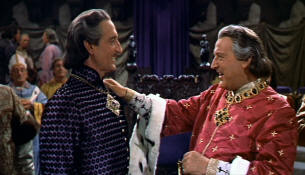 The King approves of Ravenhurst's idea. |
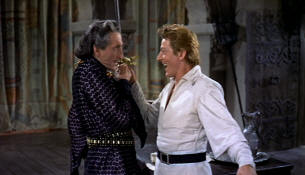 Ravenhurst crosses swords with Hawkins |
"Outstanding is our old friend Basil Rathbone, back in his familiar role of plotter and swordsman extraordinaire. He is in excellent form." —Ronald B. Rogers, The Village Voice, April 11, 1956
"Mr. Kaye is at his scintillating best as this Cyrano de Bergerac, giving a devastating caricature of the mythical invincible swordsman we have inherited from Alexander Dumas, Anthony —Prisoner of Zenda— Hope and Douglas Fairbanks, Senior." —The Standard, 23 March 1956
"If you've ever laughed when you shouldn't have at some of those movies about early England, you can feel free to roll in the aisles at this one—and probably will. ... The dialogue's a riot, so's the plot." —Modern Screen, February 1956
"This sly dig at Hollywood's mediaeval 'epics' gives Danny plenty of opportunity for clowning, singing, dancing, straight acting, a touch of light romance and lots of swashbuckling swordplay." —West Sussex County Times, 13 April 1956
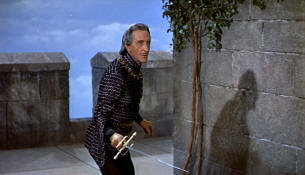 Ravenhurst is surprised that Hawkins (having been hypnotized) fences well. |
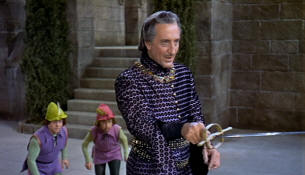 Ravenhurst about to be tripped by little people |
"With his usual flair for making you love the underdog, Kaye is delightful in this latest Technicolor pleasantry." —Rahna Maughan, Screenland Plus TV-Land, March 1956
"Lots of fun, a good number of laughs, many humorous situations, and a fast-moving plot are to be found here. ... There is just the right amount of tongue-in-cheek satire to put this over as very good entertainment for everyone, young and old alike." —Motion Picture Exhibitor, February 8, 1956
"A very funny spoof of all the movies which have huffed and puffed seriously about knights, fair ladies, dashing Robin Hoods and general derring-do." —The Film Daily, January 27, 1956
"The age of chivalry is dead. Danny Kaye kills it. A burlesque of all swashbuckling epics. The plot is marvelously complex. A fine comic idea, a hilarious climax. Kaye is funny in everything he does and The Court Jester gives him a chance to do everything. The most lavish comedy ever made. Hard to beat." —William K. Zinsser, The Herald Tribune, January 27, 1956
|
The Court Jester Danny Kaye is back and this is cause for huzzahs at the box-offices. In his latest opus, a satirical musical, Kaye is given ample opportunity to demonstrate his inimitable gifts as a pantomimist, dancer, singer and exponent of slap-stick, and he combines them to the fullest measure. Even though the story line is peppered with incidents and coincidences that strain the credulity, even for a burlesque, Kaye never fails to delight and entertain. "The Court Jester" is reported to be the most expensive comedy ever produced, $4,000,000 having been invested, and the outlay is in evidence by the massive sets and the hordes of players and extras. It is reasonable to believe, however, that the producers will get back their investment with a neat profit because it is the kind of a picture that should attract all types of audiences. Kaye has been surrounded with a capable supporting cast including Britain's Glynis Johns, Basil Rathbone, Angela Lansbury and Cecil Parker, as well as Mildred Natwick, the latter a witch who is no slouch when she wishes to cast spells on the defenseless Kaye. Choreographer James Starbuck has created some spectacular production numbers. But a highlight of that category doesn't come strictly under the heading of choreography. It is a close-order drill performed by the American Legion Zouaves drill team of Jackson, Mich. The team is utilized in a scene in which Kaye is knighted in an elaborate court ceremony. As for story, it's along the Robin Hood lines and takes place in 12th Century England. Parker, as the usurper king, is told that the infant king of the true royal family, which has been massacred, is still alive. He fears that he will be dethroned if the real ruler is found. The Black Fox, played by Edward Ashley, is the leader of the Robin Hood-type gang which seeks the restoration of the rightful dynasty. Among the Fox's followers are Kaye, a rather timid fellow, and Miss Johns. Through various manipulations, Kaye finds his way to the palace impersonating a contracted court jester who, by way of court intrigue, is to kill off some prospective suitors for the hand of the princess, Miss Lansbury. Kaye comes under the influence and spell of the witch, and when he is under the spell he is tough and courageous. A snap of the finger can change his personality. Needless to say, Kaye, after many riotous situations, plots and subplots, exposes the conspirators, engages in duels and restores the baby to the throne. While the pace is fast when Kaye is on the screen, there are a few dull spots that crop up when motivation of plot is necessary. But on the whole, the hilarious moments offset the slower sequences. Norman Panama and Melvin Frank wrote, produced and directed the film. Five songs were contributed by Sylvia Fine and Sammy Cahn. The color by Technicolor does much to enhance the spectacular elements. —Al Steen, Motion Picture Daily, January 27, 1956 |
"Kaye's new comedy a delightful spoof, a slick satire on age-of-chivalry movie spectacles. The versatile Kaye sings, dances and clowns superbly and the supporting players do a grand job. A succession of hilarious misadventures. You'll find it fun." Rose Pelswick, Journal-American, January 27, 1956
"Danny Kaye gives his best performance yet in one of the funniest films to come from Hollywood in years. It is The Court Jester, a spectacular skit on the Ye Olde Merrie England costume film—and packs a laugh a minute." —The Daily Mirror, 10 February 1956
"The Court Jester is that rare thing—a film with a universal appeal." —The Worthing Herald, 16 March 1956
"Kaye is eminently likable here, impressively verbal, and smart enough to surround himself (and really share the screen) with top actors, including a pert Glynis Johns, young and lovely Angela Lansbury and a deliciously villainous Basil Rathbone." —Stephen Whitty, Family Viewing: The Court Jester , February 21, 2015
CANDIDS:
Back to Page One, review of The Court Jester.
Visit Page Three for pictures of Posters, Lobby Cards and Promo Photos.







